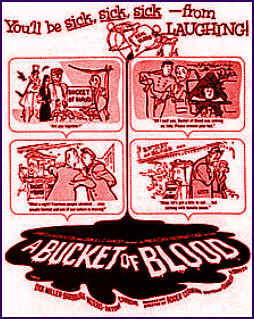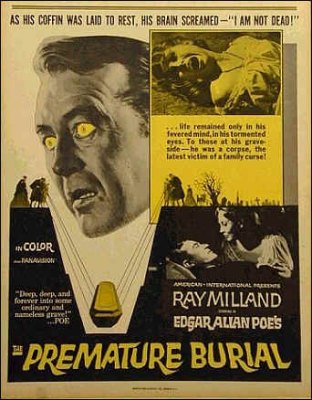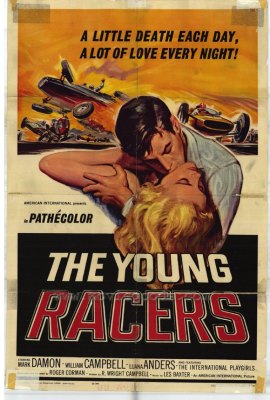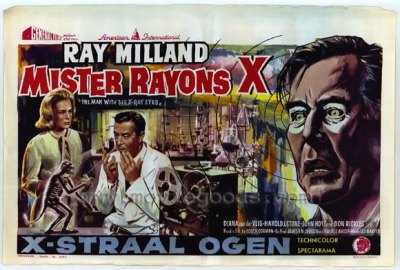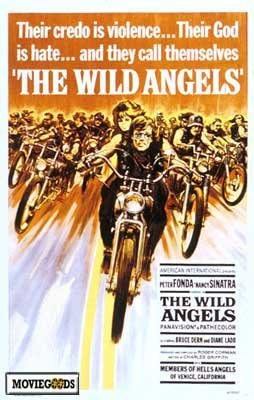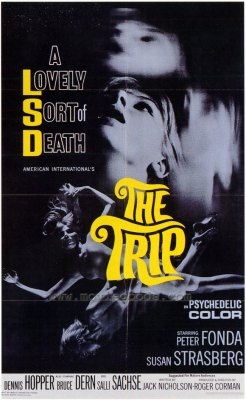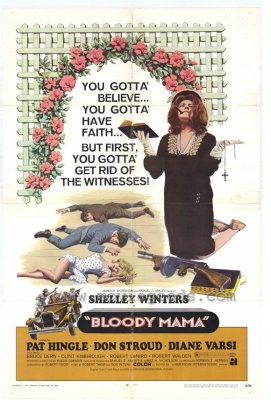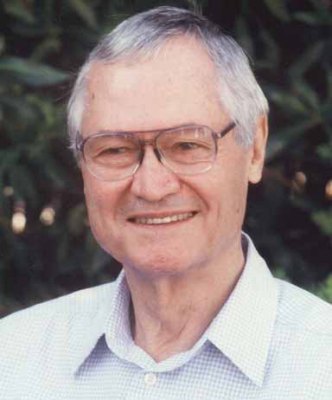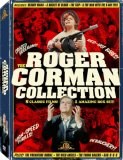| Reviews & Columns |
|
Reviews DVD TV on DVD Blu-ray 4K UHD International DVDs In Theaters Reviews by Studio Video Games Features Collector Series DVDs Easter Egg Database Interviews DVD Talk Radio Feature Articles Columns Anime Talk DVD Savant Horror DVDs The M.O.D. Squad Art House HD Talk Silent DVD
|
DVD Talk Forum |
|
|
| Resources |
|
DVD Price Search Customer Service #'s RCE Info Links |
|
Columns
|
|
|
Roger Corman Collection (A Bucket of Blood/Premature Burial/X/The Young Racers/The Wild Angels/The Trip/Bloody Mama/Gas-s-s-s)
All this is absolutely true, but it tends to undermine Corman's talents as a director. Bottom-of-the-bill helmers like Jerry Warren, Edward L. Cahn and Richard E. Cunha were working with the same amount of money and time (often more so) Corman had back in the 1950s but there's not a big demand for retrospectives and monographs of their careers today. That's because the secret to Corman's enduring popularity wasn't just that he could bring his films in ahead of schedule and under-budget, or that he had his finger on the pulse of the drive-in market, or even that he was shrewd enough to hire hungry young talent to work for him for next to nothing. Rather, it was his intelligence, taste, and ingenuity in raising bottom-of-the-bill fodder into something far better than anyone might reasonably have expected. His pictures were always commercial - indeed, usually highly exploitable - but for no extra time or money was able to infuse them with (among other things) richer and more complex characterizations, camerawork and (especially) blocking that was infinitely more compelling than the flat style of his contemporaries,
MGM's The Roger Corman Collection is a well-chosen set of eight films, all either underrated and/or or significant points in the director's career: A Bucket of Blood, The Premature Burial, The Young Racers, X, The Wild Angels, The Trip, Gas-s-s-s, and Bloody Mama. Six have been released to DVD before - same transfers, same menus, same everything - so this review will concentrate on the new-to-DVD The Young Racers and Bloody Mama while giving cursory reviews of the others.
A Bucket of Blood (1959)
One of Roger Corman's lesser-known discoveries, but one that played a hugely significant role in developing his reputation was screenwriter Charles B. Griffith, who died in relative anonymity just a few weeks ago at the age of 77. Just as Corman's direction was more intelligent than other directors working at the same budget level, Griffith's scripts were similarly smart. It Conquered the World (1956) and Attack of the Crab Monsters (1957) may have lurid titles and foolish-looking monsters, but Griffith's attention to characterization in both of those films and the general cleverness of their storylines still surprise audiences.
A Bucket of Blood was the first of three jet black horror comedies (with science fiction elements in the case of the latter two, The Little Shop of Horrors, 1960, and Creature from the Haunted Sea, 1961) Corman and Griffith made on the cheap. The really, really cheap. A Bucket of Blood may have cost as little as $25,000 to make; except for a few exteriors, the entire film revolves around just two sets: a beatnik cafe and the crummy apartment of its nebbish hero/serial killer, hapless Walter Paisley (the great Dick Miller).
The story is simple: desperately wanting to fit in with the mostly pretentious pseudo-intellectual beatnik types at the cafe where he works as a busboy, Walter Paisley finds acceptance and acclaim as sculptor. What his newfound friends and admirers don't realize is that Paisley's haunting sculptures are dead bodies, covered in clay in poses that capture the moment of death.
Roger Corman was too cheap to properly copyright his early movies and all three of these pictures have fallen into the public domain. Inadvertently, however, the proliferation of these titles as bargain VHS and, later, DVD releases probably boosted Corman's reputation in ways they might not have had the films been protected but not as widely and cheaply available. (No doubt Jack Nicholson's brief but memorable appearance in The Little Shop of Horrors helped sell thousands of copies of that particular title.) A Bucket of Blood is a strange bird; it's really more a satire on beatnik pretentiousness than a horror comedy. It was popular to poke fun at the movement at the time (see Funny Face for a big-budget example of this) but Griffith's script is dead-on target most of the time, with the beatniks' poetry especially funny.
Like most of Corman's early films, A Bucket of Blood is just as easy to vastly overpraise as it is to dismiss as low-budget junk. It's so threadbare that it resembles a filmed one-act play (it's only 66 minutes long) more than a movie-movie, though on these terms it's also quite entertaining, if approached with low expectations. It's very funny at times but also crudely plotted, the kind of film where everyone involved, especially its cast, obviously had a ball making it and this sense of fun is conveyed to the audience.
Dick Miller is certainly a delight to watch. The busy character actor became a favorite of the younger generation of film buffs-turned-filmmakers, especially Joe Dante, who frequently casts Miller in his pictures - often as characters named Walter Paisley.
Premature Burial (1962)
Corman's career ratcheted up a notch when he began helming a series of features adapted from the works of Edgar Allan Poe. House of Usher's (1960) budget was ten times that of A Bucket of Blood (though still cheap by A-picture standards of the period) but proved enormously successful. He made eight such films in all, more or less, and all but Premature Burial starred Vincent Price. Probably for this reason, the casting of Ray Milland in the leading role instead of Price, Premature Burial has been regarded as the kind of bastard son of the Corman-Poe films. In fact it's vastly underrated and overall superior to a few of the better-remembered entries in the series, like Tales of Terror, made later that same year.
Fearing that he has inherited his father's catalepsy, Guy Carrell (Milland) becomes obsessed that he might have an attack, mistakenly pronounced dead and buried alive like his father. He marries devoted Emily Gault (Hazel Court) but his happiness is short-lived. Pretty soon, Guy is constructing an elaborate (comically so, like a Rube Goldberg invention) fail-safe crypt equipped with endless escape devices, but can he avoid the seemingly inevitable?
Poe's stories were rooted in the psychological, and where Price was marvellous at expressing a tortured soul in extravagantly theatrical terms, Milland is superb here at projecting a more clinical obsessive-compulsive disorder. He's erudite and at times overbearing, making it difficult for others to try and reason with him, but that's exactly the point. Some have misinterpreted the character's aloofness as Milland phoning in the part but that just isn't the case. Though largely unstated, it's like he's intelligent enough to realize his grand scheme with the elaborately rigged crypt is the stuff of madness, yet he stubbornly tries to convince his friends and family that it's all perfectly rational given his family's medical history.
Others have criticized the film's alleged cheap look, though budget-wise it's about on par with Corman's other Poe films. The odd thing about these obviously soundstage exteriors in all the early Poe films is that when shown on television back in the 1970s and early '80s in awful panned-and-scanned transfers the cheapness was somehow accentuated. Yet, in 35mm 'scope prints and now on DVD one can really appreciate the dreamlike artistry of art director Daniel Haller's beautiful sets.
The Young Racers (1963)
The most surprising thing about this story of professional race car drivers is its striking similarities to John Frankenheimer's Grand Prix, released three years later. Both were filmed throughout Europe on the Grand Prix circuit and through careful editing convincingly integrate real racing footage with actors behind the wheel of actual race cars, Lotuses in this case. Both films attempt to get inside the heads of these daredevils and reveal their inmost thoughts, fears, and motivations, though in Frankenheimer's film the emphasis is more focused on their passion for driving, the mechanics of racing, and the sub-culture among the various drivers and owners. In Frankenheimer's film the pressures of racing impact the drivers' relationships with outsiders, particularly women, while in Corman's film it's just the reverse: that emotional baggage and psychological problems are symptomatic of drivers.
In any case the film is a remarkable achievement production-wise. Despite being filmed in color on location in Ireland, Monaco, France, Belgium, and elsewhere, The Young Racers was produced for a tiny fraction of Grand Prix's $9 million budget, perhaps as little as $150,000, though that seems unlikely. In any case it still probably cost less than $400,000 to make.
The picture is very European not just in terms of its locales but also in its impressively adult characterizations; an empty-headed film for teenagers at the drive-in it's not. (For this reason AIP co-head Samuel Z. Arkoff probably hated it.) Former racer Stephen Children (Mark Damon) sets out with help from secretary Henny (Luana Anders) to write a vicious expose, disguised as a novel, about Grand Prix champion Joe Machin (William Campbell), an "arrogant, ruthless, crude, and altogether hateful human being."
Stephen's girlfriend Monique (Beatrice Altariba) left him for Joe, but he's already dumped her for Lea (Margarete Robsahm), whom he openly seduces in front of wife Sesia (Marie Versini). Meanwhile, Joe's brother, Robert (screenwriter R. Wright Campbell, also actor William's real-life brother), is in love with Sesia, while Joe's predatory nature soon has him trying to seduce Henny.
Despite some great racing footage, with cameras mounted on the Lotuses in shots anticipating Frankenheimer's film, The Young Racers is mostly a character portrait of Joe and Stephen, and to a lesser extent Robert and the women in their lives. Joe is a remarkably authentic portrait of the dark side of celebrity, a truly repellent character that many nonetheless find attractive. What's fascinating about Campbell's screenplay is that it moves in unexpected ways, with Stephen drawn into a close if competitive friendship with Joe: Stephen loses sight of his initial goals while his mining of Joe's psychology causes the abusive, arrogant ladies man to become more thoughtful and introspective. Though talky, the film is never boring thanks to Corman's staging, which keeps things moving and visually interesting, and he gets very good, edgy but understated performances from his cast, particularly the wonderful Luana Anders and both Campbells. Corman's direction also understates some of writer Campbell's overdone symbolism, most obvious in the names of the characters (Children, Machin, Magee's Sir William Dragonet, etc.).
The Young Racers is fascinating for other reasons. When Irish actor Patrick Magee (A Clockwork Orange) shows up near the end, I suspected his voice was dubbed by someone else, and in a scene between Magee and Mark Damon it suddenly hit me: Magee might very well be dubbed, but clearly Damon is dubbed as well - by none other than William Shatner. (Corman had made The Intruder with Shatner the year before.) I have no idea why the decision was made to do this, but it's so well done technically that this reviewer didn't catch on until the film was nearly over.
During this time Corman liked to save money by having his screenwriters serve double duty as both writers and actors, which is why Robert Towne and Charles Beaumont, among others, turn up in his movies. Corman himself is in the picture: he's the guy in sunglasses at the beginning (grinning, of course) who tells Joe, "Great race! Great!" Towne, writer Charles B. Griffith, and future producer Menahem Golan reportedly all worked as assistant directors and/or did second unit work; they're probably in the film somewhere, too. Francis Ford Coppola, who's credited with the sound but also did some second unit shooting, turns up onscreen as well, unmistakable as a husband whose wife briefly flirts with Joe. Coppola famously was given a big break by Corman during production; with Anders, Campbell, and Magee he shot Dementia 13 at about the same time using most of the same crew. (One story goes that the entire film had to be looped in postproduction because Coppola claimed to know how to operate sound equipment he knew nothing about and screwed up the entire sound recording.)
X (1963)
First things first. The name of this movie is not X - The Man with the X-Ray Eyes: that was only in the advertising. Nowhere in the movie is the picture called anything but X. Now that's out of the way....
Seemingly inspired by those ads in the back of comic books for X-Ray glasses, X follows Dr. James Xavier (Ray Milland again) on a odyssey with eyedrops enabling X-Ray vision - in an amazing little film that's like a bright Eastmancolor version of Nightmare Alley. After accidentally killing associate Harold J. Stone, Xavier moves from carnival attraction to inner-city faith healer to fugitive from justice. As his visual spectrum widens he grows more and more insane, overwhelmed and anguished by the onslaught of newfound sight that comes at the expense of anything like normal vision - or even darkness. He's like The Incredible Shrinking Man's Scott Carey but without even a single moment of relief; so strong is his X-Ray vision he can't even sleep - he sees right through his closed eyelids. He stops relating to people and even everyday objects once they lose all recognizability.
X disappoints many first-time viewers for the same reasons those X-Ray glasses did: neither delivers on its implied promise of such voyeuristic delights as seeing right through the dresses of pretty women. The modest budget precluded any fancy optical effects, but what made it onscreen is beguilingly abstract on its own terms. Though dramatically clunky at times (Stone's death scene is particularly ludicrous, and there's an unintentionally hilarious bit that finds Milland dancing something like "The Twist" at a cocktail party like an arthritic elephant) Milland gives a wonderfully tortured performance that compliments Corman's lean pacing; it's really a shame they made no other films together after this.
(Spoilers): By the end, the film becomes so hypnotic it far transcends its exploitation, sci-fi programmer elements, especially when Xavier, his eyes now a creepy, glassy black, stumbles upon an old-fashioned tent revival meeting with evangelical types. "There are great darknesses," Xavier warns the congregation, "Farther than time itself. And beyond the darkness...in the center of the universe...the eye that sees us all." For Xavier, getting closer to God isn't comforting, it's terrifying beyond words.
The Wild Angels (1966)
It's ironic that one of Roger Corman's worst movies, if undeniably one of his most influential, should be also arguably his biggest hit ever. On a budget of just $360,000, The Wild Angels, generally regarded as the first of an endless stream of biker movies, earned $7 million in domestic rentals alone; by 1980 it had grossed around $14 million.
Peter Fonda's "Heavenly Blues" and Bruce Dern's "Loser" are the leaders of the Venice chapter of the Hell's Angels, the notorious motorcycle gang. Loser's attempts to retrieve his stolen bike lands him in the hospital after he shot by the cops after stealing one of their motorcycles. Mainly though, the Hell's Angels like to party, without any interference from "The Man." Nancy Sinatra plays Fonda's girlfriend, while Diane Ladd, married to Dern at the time and here looking a lot like daughter Laura Dern (who was conceived during filming), plays Dern's wife.
Roger Corman had grown weary of the Poe series, and was both intrigued by and saw a lot of money to be made in the growing counter-culture movement. The Wild Angels was not only wildly successful financially, it also attracted a good deal of international critical scrutiny, and was even nominated for a Golden Lion at the Venice Film Festival (!). It's definitely is a clear antecedent to Easy Rider (1969) and very well directed, though its virulently anti-establishment tone and (especially) its dialogue now one seem awfully silly. Consider the film's big showpiece, Fonda's speech near the end, delivered like testimony by Christ before Pontius Pilate: "We wanna be free! We wanna be free to do what we wanna do. We wanna be free to ride. We wanna be free to ride our machines without being hassled by The Man!...And we wanna get loaded. And we wanna have a good time. And that's what we're gonna do. We are gonna have a good time....We are gonna party!"
Future director Peter Bogdanovich was the latest of Corman's discoveries at the time, and he's since claimed, perhaps rightly so, to have played a larger role in the production than he's actually credited for, stating that he rewrote Charles Griffith's screenplay and also worked as an editor (with Monte Hellman), cinematographer, second-unit director, etc. To what extent his role was in the film's ultimate success (if any) is perhaps impossible to say.
The Trip (1967)
Like X>, The Trip attempts and in some ways succeeds at visualizing the unvisualizable, in this case, getting inside the head of television commercial director Paul Groves (Peter Fonda) as he experiences LSD for the first time, aided by hippie pal/guru John (Bruce Dern) who tells him to "go with it, man" - prompting Psychotronic to ask, "Would you trust Bruce Dern?" Produced right on the cusp between the time LSD was still legal and fashionably used by famous celebrities like Cary Grant, and when it became verboten (on October 6, 1966) and soon a favorite of the Woodstock generation.
Written by Jack Nicholson, The Trip admirably fleshes out Fonda's character in intelligent ways, and his one-on-one scenes with Dern and others are especially well-written. The short scene at the laundromat with Barboura Morris is a terrific little vignette, and Nicholson seems to have written the picture with particular actor-friends in mind. His script certainly compliments Fonda's performance: perhaps no actor more perfectly imbued a balance of middle class respectability with a believable soul-searching yearning. He was never a great actor, but eventually he became a much underrated one. Corman and the actors sell the hard-sell material. Everyone gives sincere performances, and quite unlike counterculture characters usually seen in the movies (and especially on TV shows like Dragnet), the slang and sensibilities here are impressively accurate, this despite the fact that Corman and most of his cast were really as much outsiders as they had been on The Wild Angels. (Despite his wacko screen persona of the period, Bruce Dern was really a self-described square, a health nut and avid long-distance runner.)
The Wild Angels and The Trip sent Corman off in new and interesting directions, and while both films were successful at the box office, they also made distributor AIP nervous, so much so that for the first time that began tampering with the final cuts Corman provided them. (To some degree this was understandable; if it were made today The Trip would unquestionably launch a class action lawsuit. The film probably directly inspired first-time trips around the globe.)
Bloody Mama (1970)
Roger Corman's penultimate film for AIP was this violent, sexually explicit account of Depression era bank robber and kidnapper Kate "Ma" Barker (Shelley Winters) and her brood of outlaw sons and various hangers-on, including (fictional) bisexual ex-con Kevin Dirkman (Bruce Dern) and prostitute Mona Gibson (Diane Varsi). AIP regular Don Stroud, Robert Walden, and Clint Kimbrough played three of Ma's boys, but the film is remembered largely for the choice early role afforded to relative neophyte actor Robert De Niro.
The film can't shake nor can it really compete with its obvious inspiration, the hugely influential Bonnie & Clyde (1967), though both films take a psychological study approach with their leading characters and each presents a "family" of a sort existing in self-contained, enclosed little universe. But where Bonnie & Clyde and their cohorts are sympathetic villains with sexual and other problems, the Barker family are merely a bunch of monstrous criminals two steps removed from the family in The Texas Chain Saw Massacre (1974).
The film tries to do Bonnie & Clyde one better with an almost endless parade of depraved acts: incest (Ma takes turns sleeping with all her boys, as well as Dirkman), hetro-, homosexual and child rape, murder, drug addiction, etc. The psychological underpinning makes it all no less pleasant to watch, but at least none of it is dramatically unjustified, and the acting all around is excellent. The film is almost half over before it finally builds some momentum; the first half is a badly structured series of vignettes that don't really lead anywhere while telling us less about the characters than perhaps it should.
The film isn't quite artless, though its main asset this time are the performances rather than Corman's direction, which keeps things moving but is visually pretty vacuous. Ma Barker was the kind of role Actor's Studio alum Winters could sink her teeth into, and her dedication to the role (which extended, reportedly, to sitting up all night with a corpse at a mortuary for inspiration) is obvious, though much of her dialogue is archly cynical and artificial. De Niro's glue sniffer/drug addict for the most part plays second fiddle to Stroud's tortured sadist. After the Barkers kidnap millionaire cotton broker Sam Adams Pendlebury (Pat Hingle, excellent), there's an extremely good scene where Sam subtly manipulates Stroud's hulking Herman, who becomes obsessed with the color of Pendlebury's blindfolded eyes, thinking they might be the same deep blue of his weak-willed but kind father (Alex Nicol). When Herman refers to his victim as "Buddy," Pendlebury insists, tied-up and all, on being called Sam. It's a great scene, one of the few in the film that lives up to its potential. Likewise, the seduction-rape scene between Dern and Walden (one of the most versatile character actors of the '70s) is also extremely well acted.
John Alonzo (Chinatown) was the film's cinematographer and he does a fine job though the film's low budget betrays him here and there. There's a scene with Stroud and Varsi in a car where outside the window contemporary automobiles are clearly visible, and in the prison scene with Dern and Walden a swastika can be seen scratched into a background wall even though it's supposed to be 1929. Don Randi's score is quite poor, distractingly so and virtually non-stop; by the time the film is half over, you really want it to shut up. The picture was shot entirely on location in Arkansas.
Gas! - Or - How It Became Necessary to Destroy the World in Order to Save It (1971)
In 1970, Roger Corman produced Gas-s-s-s. Many thought Corman's Gas-s-s-s stank to high heaven, and Sam Arkoff and Jim Nicholson, the heads of AIP, were offended at the way Corman cut it, and were eager to produce their own, superior Gas-s-s-s that could be unleashed in theaters across America.
Sorry. I couldn't resist.
Advertised under its better-known (but not onscreen) title, Gas-s-s-s was Corman's last film for AIP, and his penultimate film as a director for many years. (After this he made Von Richthofen and Brown/The Red Baron (1971) for United Artists, but didn't direct again until 1990's Frankenstein Unbound, an intriguing little film barely released by 20th Century-Fox.) Corman usually had his finger on the pulse of teenage/young adult market, but he erred badly here. Though the film is at times quite watchable more often than not it's just way off-target. The picture was taken out of his hands and, apparently, scenes were added, removed or altered; the final running time is just 79 minutes. On the other hand, what's there will still give you a pretty good idea what Corman had in mind.
After a poisonous gas created by the military for chemical warfare purposes accidentally kills everyone in the world over the age of 25, various social factions band together trying to recreate the world in their image: (fascist) football jocks and police officers, intellectuals, young capitalists, etc. The picture follows a sextet of free-spirited hippies: lovers Coel (Bob Corff) and Cilla (Elaine Giftos); pregnant music lover Marissa (Cindy Williams); Carlos (Ben Vereen), a self-styled cowboy; sharpshooter Hooper (Bud Cort) and his fiancee, Coralle (Talia Coppola [Shire]). Their odyssey, significantly not unlike those seen in X and The Trip , is a mishmash of political and social satire, in-joke movie and other pop culture references (from the Edgar Allan Poe movies and The Wild Angels, among others), music and apocalyptic sci-fi.
The soon-to-be-famous cast, all in their prime, are definitely worth watching, but there's an air of desperation to the film, most obvious in the non-stop barrage of would-be jokes most of which fall flatter than a lead balloon. One can almost hear the crickets chirping when it played to aghast drive-in audiences.
Video & Audio
The eight films in this set are on four single-sided, single-layer discs; all but The Young Racers and Bloody Mama have been released before, and the transfers are identical. Box art text claims A Bucket of Blood is 2.35:1 'scope but that's a typo. The film was released in matted widescreen, probably 1.85 to 1 (it frames quite nicely at 1.78:1 on widescreen TVs) and MGM really missed the boat here: a new 16:9 enhanced transfer could have set it apart from the scads of public domain releases out there. The other previously released titles have good-to-excellent 16:9 enhanced transfers.
Likewise, The Young Racers is 4:3 letterboxed at 1.66:1 but frames well when zoomed on 16:9 sets. It should have been enhanced as well. The colors are muted but seem accurate and the image is reasonably sharp if not great.
Bloody Mama, though 16:9 enhanced, is also a disappointment. The image is at once soft and grainy, suggesting an IN (inter-negative) rather than an IP was sourced. The framing seems tight in some shots, but the worst offender is the audio, which has a lot of buzzy noise and which requires considerable amplification. The audio is so bad at times it's hard to make out the dialogue.
The mono audio on the remaining titles is adequate. The Premature Burial, The Wild Angles, The Trip, and Gas-s-s-s have English and French audio and English, French, and Spanish subtitles; A Bucket of Blood and X are English only with optional English, French, and Spanish subtitles; The Young Racers and Bloody Mama have Spanish audio but no French subtitles.
Extra Features
Once again, MGM missed the boat in not providing a booklet or any extras with the two new titles; The Young Racers and Bloody Mama are bare bones and don't even include a trailer. The previously released extras on the other discs include a few Roger Corman commentaries and featurettes.
Parting Thoughts
Though The Young Racers would be worth seeking out if it were available separately, and Bloody Mama is worth seeing if not exactly good, the boxed set isn't really worth picking up for those Roger Corman fans who already own all or most of the other films in this set. If you've skipped them until now, the selection of titles, and despite the hit-and-miss transfers and dearth of extras on the new releases, is Recommended.
Film historian Stuart Galbraith IV's most recent essays appear in Criterion's new three-disc Seven Samurai DVD and BCI Eclipse's The Quiet Duel. His audio commentary for Invasion of Astro Monster is now available.
|
| Popular Reviews |
| Sponsored Links |
|
|
| Sponsored Links |
|
|
| Release List | Reviews | Shop | Newsletter | Forum | DVD Giveaways | Blu-Ray | Advertise |
|
Copyright 2024 DVDTalk.com All Rights Reserved. Legal Info, Privacy Policy, Terms of Use,
Manage Preferences,
Your Privacy Choices | |||||||









